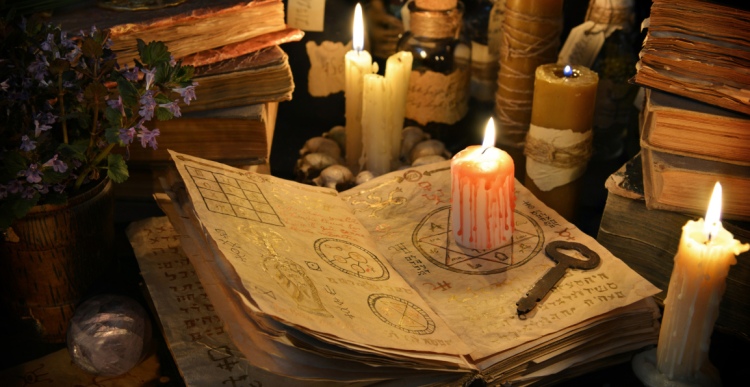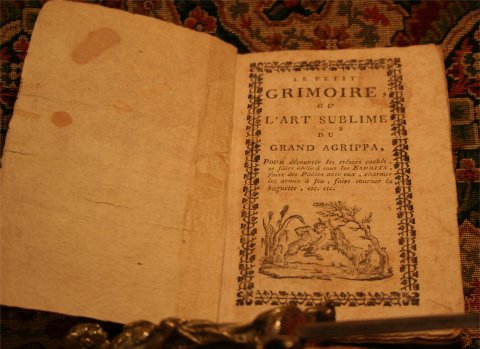A Grimoire is a book of magic, often containing spells, conjurations, charms, divinations and other occult wisdom. Grimoires have ancient origins and are thought to have influenced many societies worldwide.
The term grimoire is thought to come from the French word ‘grammaire’ (grammar), which historically was used to describe any book written in Latin or that was hard to understand. It was only in the 18th century the term gained recognition specifically as a book of magic.
Grimoires have been found worldwide, including the Caribbean, Southeast Asia, Europe, and the Middle East. Some grimoires describe how to make protective talismans and amulets, charms for healing illness, finding love, warding off evil, or how to summon and dismiss supernatural entities or beings. However some grimoires contain information on how to control people or call up evil entities, leading to the negative connotations associated with these books of magic.
It is also thought that due to the powerful language and symbology used within, the grimoire itself contains magical powers. Historically, the church banned these books of magic, and very few authentic grimoires from history have been preserved.
Some popular grimoires include:
The Sixth and Seventh Books of Moses
Originating in the 18th century, this grimoire has spread from Germany to America, influencing Pennsylvania Dutch, African American, Vodou/Hoodoo, and Rastafarian folk-magic cultures. It contains some Kabbalistic or pseudo-Hebraic mystical symbols and sigils, spirit conjurations and psalms. Interestingly, the first five books of Moses are traditionally the first five books of the Bible.
The Key of Solomon / Clavis Salomonis
Several books thought to have been written by the biblical King Solomon have been around since at least the first few centuries AD. The Key of Solomon was thought to have been written in the 14th century, and was translated in the 19th century by a man who heavily influenced the Golden Dawn occult movement. This inspired the Lesser Key of Solomon, co-written by the famous Aleister Crowley.
The Sworn Book of Honorius / Liber Juratus
This grimoire is attributed to Honorius of Thebes, and is second only to Solomon in terms of notoriety. A collection of work by several magicians in 13th century Germany, it contains prayers and invocations to receive visions and gain knowledge and wisdom.
The Book of the Sacred Magic of Abramelin the Mage
Written in the mid-15th century, this grimoire was later translated to English and became heavily influential in the Golden Dawn movement and Aleister Crowley’s Themela. A collection of magical and Kabbalistic secrets, it contains spells to find love, become invisible, and contact one’s guardian angel. An important source of ceremonial magic.
Picatrix
Originally written in Arabic, this grimoire was one of the first books on astrological magic. It was thought to have been written in the 10th or 11th century, and translated into Latin in 1256. It became heavily influential on Western magic and was used by many Renaissance mages.
The Three (or Four) Books of Occult Philosophy by Agrippa
Written by German occultist Cornelius Agrippa, these grimoires deal with elemental, celestial and intellectual magic including astrology, Kabbalism, numerology and alchemy. It is thought that the first three books were written by Agrippa, however the fourth book on spirits, written after his death, is still attributed to him.
Grand Grimoire / The Red Dragon / Dragon rouge
Considered to be one of the most dangerous grimoires in existence, this book of black magic claims to have been written in the 16th century, but more likely originated in the grimoire boom in 18th century France. Its main purpose is summoning Lucifer and other demons of hell, and was circulated as far as the French colonies of the Caribbean.
The Magus
A rare grimoire of ceremonial magic, it was written in 1801 by British occultist Francis Barrett. The Magus discusses alchemy, astrology and the Kabbalah, focusing on 17th century occult science.
Book of Shadows
Probably the most influential grimoire for Wiccans is Gerald Gardner’s Book of Shadows, originally named Ye Book of Ye Art Magical. It was thought to have been written by Gardner with his High Priestess Doreen Valiente and perhaps occultist Aleister Crowley. Gardner claims to have received a copy from a secret coven of witches which he believed to have survived through the centuries.
Originally, there was only one Book of Shadows for every coven, however now that solitary Wicca has risen in popularity, most witches keep some sort of Book of Shadows. It was also thought that a witch’s Book of Shadows should be destroyed upon their death, protecting their secrets from others. Today, most Book of Shadows (BOS) contain rituals, spells, magical history, rules and reference, as well as a diary of your own magical workings. Some suggest the BOS should be divided into spell book and magical diary. It is also suggested that the BOS should be handwritten, as it is thought to imbue personal energy into the text.
The Grimoire, or Book of Shadows, has achieved cultural recognition and media exposure through shows like Charmed, The Craft, Buffy and Vampire Slayer, Harry Potter, The Vampire Diaries and The Secret Circle. And while the depictions seen on TV are fictitious, real-life grimoires have preserved the magical and mystical traditions of Judaism, Islam, and Christianity, influenced the development of science, and had cultural impacts throughout most of the Western world.
Wiki – Grimoire
Wiki – Book of Shadows
Owen Davies Article
Sacred Texts
Top Ten Historical Grimoires
Top Ten Grimoires
© A Year And A Day (2013)






Fascinating. ^^
I like it